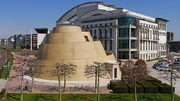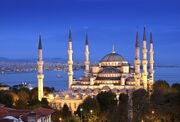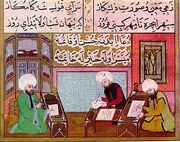Motto | |||||
| Anthem | "Glory to Barmenistan" | ||||
| Capital | Sekhmet | ||||
| Largest city | Varishehr | ||||
| Language | Brmek | ||||
| Religion main |
Ahmadism, Felinism | ||||
| others | Barmenian Apostolic Church | ||||
| Ethnic Group | Brmek, Kathuran | ||||
| Demonym | Barmenian | ||||
| Government | Theocratic monarchy | ||||
| Legislature | Madjlis | ||||
| Twin Sultans | Intrsmor and Jemrjkai (Thaller Family) | ||||
| Forward-souled person and Speaker of the Sultan | Táhirih Sirghastané | ||||
| Area | 856,800 km² | ||||
| Population | 99,620,894 | ||||
| GDP Total: |
2,496,562,386,324 BAR | ||||
| per capita | 25,060 BAR | ||||
| Currency | Barmenistan (BAR) | ||||
| Drives on the | Right | ||||
| Internet TLD | .bar | ||||
Barmenistan (Brmek: برمستات Brmestán), officially the Twin Thallerid Sultanates of Ahmadi and Felinist Barmenistan (Brmek: نکزوبی یرلیی امادصرلی ترز نکی سلتنکنستات برمستات Nakzwibaé Jrlijé Ám'ádsrlji trzy Nkaé Sltnknstat Brmestán) is a nation situated on the continent of Majatra. It is bordered by the Verranderlijke Ocean to the west, Beiteynu to the north-west, Pontesi to the north-east, the Majatran Sea to the east, and Vanuku to the south.
Barmenistan is a Jelbic nation closely aligned with the other nations of the Jelbo-sphere, most significantly Vanuku.
Barmenistan is the historical center of several of the world's major religions, including Felinism and Ahmadism, both of which were founded in Barmenistan. The Ruhi Faith was also founded in Barmenistan.
Etymology
The Luthorian word Barmenistan has been used interchangeably with the name Barmenia. Though either name can be used, since the resurgence of Jelbicism in Barmenistan the former is preferred because it more accurately mirrors the Brmek name for the nation, Brmestán. This term is closely related to the Old High Jelbic Brme, a name still used by other Jelbic speakers.
History
Qedarite rule
Jelbo-Tukaric migrations and Beiteynuese rule
Ahmadism and the Caliphate
Rule by multiple foreign entities
Felinism
Temrkai and the Khaganate
Thallerid Ahmadi Sultanate
In the year 4266, a prince of the Thaller Family from Narikaton named Jens V ascended to rule in Barmenistan after his election by a synod of Felinist and Ahmadi holy men tasked with finding a stable ruler for the nation. Jens took the regnal name Jens I of Barmenia and converted to Ahmadism.
During the rule of Jens I as Sultan of Barmenistan (Brmek: Brmestánék Sltn), a revival of Jelbicism took place in Barmenistan, spurred heavily by active involvement from the monarchy. In the early years of the Sultanate, non-Felinists and Ahmadis were heavily persecuted, and for a time profession of Ahmadi or Felinist faith was mandatory. Following pressure from Beiteynu and Vanuku, this requirement was lifted, though public profession of 'cults' is still banned.
As the result of increased Jelbicism, Jens I and Juhn VIII, King of Vanuku, undertook the creation of the Union of the Jelbic Peoples (Brmek: Jelbijékaiék Krsyjogad) under the leadership of Juhn and Vanuku. Barmenistan became a constituent nation of the Union in 4275.
Geography
Government and politics
Government
The constitutional tradition of Barmenistan was formerly based on the principle of subsidiarity, meaning that at least in theory, matters ought to be handled by the smallest, lowest, or least centralized authority capable of addressing that matter effectively. Many matters ranging from workers' rights, environmental protection, infrastructure and laws on morality were handled at the local level, by the Pashaluks, as the federal subjects were called in Barmenistan.
Following the establishment of the Kathuran minority regime under the Republic and later the House of Nasir, the Barmenian state underwent a long period of reform and centralization, culminating in the creation of an elected nobility (replacing the old, aged system of appointed Governorship). By the time of the death of King Amfn in 3937, most of the nation's decision making came from the Assembly and the monarch.
Barmenistan was formerly governed under a system of confessionalism, a de jure mix of religion and politics based on the proportional distribution of political and institutional power among religious communities. All posts in government and seats in the legislature were apportioned amongst different religious groups according to a political agreement, based on the relative demographic weight of those groups. The Barmenian legal system also guaranteed segmental autonomy to 6 recognized communities (Israis, Abadis, Barmenian Apostolic Hosians, Selucian Patriarchal Hosians, Yeudis, and Oseyim), officially known as Kns ("Nations") in what concerns personal status law. However, following religious backlash and the rise of the Kathuran minority regime under militarist leader and President D'yaequob Eabaa, Ahmadis lived under a system of mass persecution that was only relieved (conditionally) during the regency of King Eksandr. As a result, the nation became largely Hosian in its leaning. During this time, the system of 'nations' dissolved and gave way to a framework of policy incentives and punishments that was designed to root out pro-Ahmadi elements from the nation, and even gave a cold shoulder to certain Orthodox Yeudish temples. In time the persecution of Felinists and Ahmadis resulted in a backlash of the followers of the two religions against Yeudis and Hosians, culminating in the establishment of the two faiths as the official religions of Barmenistan under the Thaller dynasty.
The "Nations" during the confessionalist regime
| Nation | Religion | Ethnicity | Knsbék |
| Ahmadi Nation | Ahmadism | Brmeks, Majatrans | Ám'ádíaék Bék |
| Kathuran Nation | Barmenian Apostolic Church | Kathurans, Brmeks, Pnteks, Arev Mardik | Patriarch of Kathura |
| Selucian Nation | Selucian Patriarchal Church | Selucians | Primate of Barmenia |
| Osean Nation | Oseyim | Yeudis, Brmeks, Kathurans | Patriarch of Dinah |
| Yeudi Nation | Yeudism | Yeudis | Chief Rebbe of Barmenistan |
| Augustan Nation | Terran Patriarchal Church | Augustans, Wrnukaek | Ambassador of Zardugal |
Monarchy
Barmenistan is governed under an absolute monarchy under the House of Thaller, and the monarch carries the title of Sultan. The Thallers gained the throne by overthrowing the fledgling government of the Republic, which had taken over following the departure of the Kathuran House of Nasir, a royal family claiming descent from the royal dynasty of the Kingdom of Arakhim and also distantly related to the Yišsérles-Bünyamin Dynasty, the former ruling house of Beiteynu and Barmenistan.
In the past Barmenistan was ruled by Shahs and Caliphs. During the Felinist era, Barmenistan was governed by the House Mede, which hails from the Seluco-Barmenians, though most of its members are not of purely Selucian descent nowadays. The traditional throne room in Varishehr as well as the institution itself was referred to as the Sun-Cured Throne. Under the Medes, the Shah/Shahbanu was not an ordinary constitutional monarch, but Jezmrjkai (Brmék: Great Protector) of the Felinist Republic. This being a result of Barmenistan's historical conflict with several monarchic powers usually affiliated with the Caliphate and Ahmadism, as opposed to Felinist Republicanism.
Political parties and elections
Foreign relations
Administrative divisions
Barmenistan is divided into six Governorates (Yntmk), each governed by a Governor (Yntmkmokai) named by the Head of State, voted on by the Assembly and retained via a vote of the people.
| Governorate | Flag | Population | Area | Capital |
| Murdhild | 
|
19,973,606 | 267,900 km² | Varishehr |
| Ikegaru | 
|
19,911,381 | 175,500 km² | Temrkaistad |
| Sisula | 
|
19,909,044 | 108,300 km² | Sísle Jezstad |
| Uthena | 
|
19,970,366 | 160,200 km² | Séleuefluz |
| Arakhim | 
|
8,486,164 | 73,600 km² | Korat |
| Kathuristan | 
|
11,365,891 | 71,300 km² | Kathura |
Military

War flag of the Caliphate
The military of Barmenia had for a long time been built around the idea of an autonomous and decentralized warrior caste. The government had only directly operated a small part of the Empire's military, and mostly subcontracted semi-military control to private intrapreneurs, bringing a system of competition to the Barmenian millitary which is believed to have led to great improvements to its quality, combined with the compulsory conscription of all young Barmenian men and women. There were also many paramilitaries belonging to one of the political parties, or acting independently or working on a regional basis. One of the more famous paramilitaries is the Legion of the Fourth Sword, who shot down a Pontesi airplane violating Barmenian aerospace.
Economy
Demographics
Religious groups
- Ahmadism 28%
- Barmenian Apostolic Church 18%
- Oseyim 4%
- Aurorian Patriarchal Church 2%
- Other 1%
- Ruhi Faith 9%
- Irreligious 5%
- Yeudism 3%
- Geraja 1%
- Jelbic Shamanism 1%
- Other 2%
Ethnicity
- Brmékai 44%
- Kathuran 21%
- Arev Mardik 7%
- Other Jelbic 7%
- Seluco-Barmenian 5%
- Augustan 4%
- Yeudi 4%
- Zaqrami 2%
- Majatran 1%
- Other 5%
Culture

Modern cat temple in Varishehr, Murdhild, combining elements of ancient Qedarite and Selucian architecture
The culture of Barmenistan has a wide mix of ethnic groups and cultures, with the Brmeks being the majority group. Barmenian culture began with the settlement of Qedarite tribes during the Qedarite Migrations.

Mosque in Varishehr

Barmenian miniature painters
Little is known about the culture of prehistoric Qedarite society apart from a few stone tablets of Cuneiform script, statues and the few ziggurats they left behind. The Qedarites were gradually conquered by Jelbic-speaking tribes migrating from the south. A central element of Barmenian culture is the convergence of customs and beliefs that occurred following the conquest of most of Majatra by Barmenistan under the Ahmadi Caliphate
Barmenian culture evolved out of the centuries of interaction between Jelbic culture and the native Majatran cultures, with the former absorbing, adapting, and modifying the cultures of conquered lands. As the starting point of the Ahmadi Empire, Barmenistan was strongly influenced by the customs and languages of other Ahmadi societies, who were in turn influenced by Jelbic Barmenian culture. As the Ahmadi Empire expanded it assimilated the culture of numerous regions under its rule and beyond, being particularly influenced by the Augustan Empire, the Qedarite cultures of Arakhim, Beiteynu, and Cildania, and Selucian culture.
Though minorities of Kathuran, Selucian, Yeudi and Dunetrekkan descent exist, nearly all Barmenians are fluent in Brmék, a dialect of the Jelbic language family, largely mutually intelligible with other Jelbic languages such as Jelbék and Pnték.


